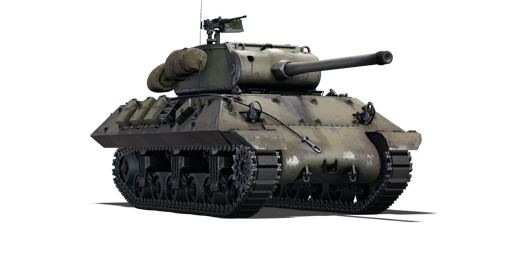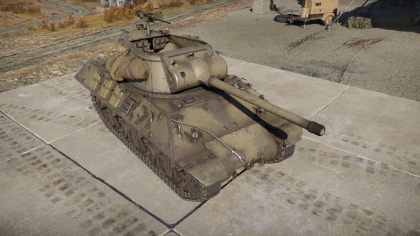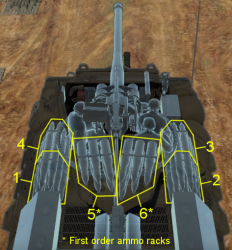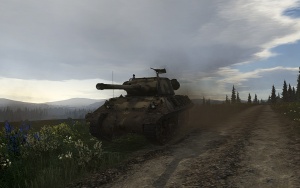M36 GMC
Contents
Description
The 90-mm Gun Motor Carriage M36 (or the M36, nicknamed the Jackson) is a Rank IV American tank destroyer with a battle rating of 5.7. It was introduced in Update 1.49 "Weapons of Victory". The M36 is a nice upgrade to the M18 GMC, owning a more powerful gun in the form of the 90 mm M3. This vehicle can be a great threat to the enemy. And can be very fun to play if used correctly.
General info
Survivability and armour
Armour type:
- Rolled homogeneous armour
- Cast homogeneous armour (Gun mantlet, Transmission area)
| Armour | Front | Sides | Rear | Roof |
|---|---|---|---|---|
| Hull | 38.1 mm (56°) Front glacis 50.8-107.8 (9-63°) Transmission housing |
19.05 mm (37°) Top 25.4 mm Bottom |
19.05 mm (42°) Top 19.05 (1-45°) Bottom |
19.5 mm Front roof 9.5 mm Engine deck |
| Turret | 31.75 mm (2-53°) Turret front 76.2 mm (°) Gun mantlet |
31.75 mm (0-21°) | 25.4 mm (2-23°) | N/A |
Notes:
- Tracks are 30 mm thick, bogies are 10 mm thick while the wheels are 20 mm thick.
- Small slivers of 5 mm armour hang off the top side hull armour, giving minuscule protections at those areas.
- Track blocks on the side hull armour allows an extra 30 mm of armour at their locations.
Mobility
| Game Mode | Max Speed (km/h) | Weight (tons) | Engine power (horsepower) | Power-to-weight ratio (hp/ton) | |||
|---|---|---|---|---|---|---|---|
| Forward | Reverse | Stock | Upgraded | Stock | Upgraded | ||
| Arcade | Expression error: Unexpected * operator. | 710 | Expression error: Unexpected round operator. | __.__ | |||
| Realistic | 442 | Expression error: Unexpected round operator. | __.__ | ||||
Armaments
Main armament
| 90 mm M3 | |||||
|---|---|---|---|---|---|
| Capacity | Vertical guidance |
Horizontal guidance |
Stabilizer | ||
| 47 | -10°/+20° | ±180° | N/A | ||
| Turret rotation speed (°/s) | |||||
| Mode | Stock | Upgraded | Prior + Full crew | Prior + Expert qualif. | Prior + Ace qualif. |
| Arcade | 14.28 | 19.80 | 24.0 | 26.60 | 28.20 |
| Realistic | 14.28 | 16.80 | 20.4 | 22.60 | 24.00 |
| Reloading rate (seconds) | |||||
| Stock | Prior + Full crew | Prior + Expert qualif. | Prior + Ace qualif. | ||
| 11.05 | 9.78 | 9.01 | 8.50 | ||
Ammunition
| Penetration statistics | |||||||
|---|---|---|---|---|---|---|---|
| Ammunition | Type of warhead |
Penetration in mm @ 90° | |||||
| 10m | 100m | 500m | 1000m | 1500m | 2000m | ||
| T33 shot | AP | 189 | 188 | 163 | 137 | 115 | 96 |
| M71 shell | HE | 19 | 19 | 19 | 19 | 19 | 19 |
| M82 shot | APCBC | 165 | 164 | 150 | 137 | 125 | 114 |
| M304 shot | APCR | 264 | 260 | 245 | 226 | 210 | 191 |
| Shell details | ||||||||||
|---|---|---|---|---|---|---|---|---|---|---|
| Ammunition | Type of warhead |
Velocity in m/s |
Projectile Mass in kg |
Fuse delay
in m: |
Fuse sensitivity
in mm: |
Explosive Mass in g (TNT equivalent): |
Normalization At 30° from horizontal: |
Ricochet: | ||
| 0% | 50% | 100% | ||||||||
| T33 shot | AP | 822 | 11 | N/A | N/A | N/A | -1° | 47° | 60° | 65° |
| M71 shell | HE | 823 | 11 | 0.4 | 0.5 | 925 | +0° | 79° | 80° | 81° |
| M82 shot | APCBC | 813 | 11 | 1.2 | 20 | 137.2 | +4° | 48° | 63° | 71° |
| M304 shot | APCR | 1021 | 7.6 | N/A | N/A | N/A | +1.5° | 66° | 70° | 72° |
| Smoke characteristic | ||||||
|---|---|---|---|---|---|---|
| Ammunition | Velocity in m/s |
Projectile Mass in kg |
Screen radius in m |
Screen time in s |
Screen hold time in s: |
Explosive Mass in g (TNT equivalent): |
| M313 | 821 | 11 | 13 | 5 | 20 | 50 |
Ammo racks
| Full ammo |
1st rack empty |
2nd rack empty |
3rd rack empty |
4th rack empty |
5th rack empty |
6th rack empty |
Visual discrepancy |
|---|---|---|---|---|---|---|---|
| 47 | 43 (+4) | 37 (+10) | 28 (+19) | 19 (+28) | 10 (+37) | 1 (+46) | No |
Notes:
- Recommended load is 20 (+27) to remove most ammo from the hull, keeping rack 6 intact.
- 1st and 2nd ammo racks are ready racks and take priority in being filled at the beginning of the battle, then fills 6, 5, 4, then 3.
- Full reload speed will be realized as long as ammo exists in either ready rack. If both ready racks are empty, a penalty to reload speed will occur.
- Simply not firing when the main gun is loaded will load ammo from racks 3-6 into 2 then 1, as long as there is ammo present in racks 3-6. Firing the main gun will interrupt the loading of the ready racks.
Machine guns
| 12.7 mm M2HB | ||||||
|---|---|---|---|---|---|---|
| Pintle mount | ||||||
| Capacity (Belt capacity) | Fire rate (shots/minute) |
Vertical guidance |
Horizontal guidance | |||
| 1,000 (200) | 577 | -10°/+70° | ±60° | |||
Usage in the battles
Play style with the M36 should be about the same as the M10. The speed is about the same and armour is still just as thin, but it has an improved turret traverse rate and a 90 mm gun, making it able to engage targets much easier.
Modules
- M82 shot (APCBC). This will greatly improve the firepower.
- Parts. So the vehicle can repair.
- Adjustment of fire, to improve gun accuracy.
- FPE, to put out fires in the event the M36 isn't done in by pyrotechnics.
- Elevation Mechanism, to improve gun accuracy.
- Personal discretion from here. M304 shot (APCR), Engine, Horizontal Drive are all good next choices. The engine is probably the best bet if taking into RB, but less important in AB.
Pros and cons
Pros:
- Access to 90mm gun and most of its ammo types
- Good handling off road
- Good gun depression
- Powered turret traverse gives better turn rate than the M10
- .50 cal machine gun for AA defence and warding off SPAA's and trucks
Cons:
- Armour is very thin, M10 thin
- Open top vehicle, vulnerable to strafing and artillery
- Slow acceleration
- Reverse speed is bad
- Outmatched by most contemporary enemy tanks in terms of armour and mobility
History
Development
United State's anti-tank doctrine called for the formation of a tank destroyer force filled with vehicles that are fast and have powerful guns. One of the vehicles designed for this job was the M10 GMC carrying the 3-inch M7 gun. While adequate at the time of its introduction, later in the war it was encountering more heavily armoured German vehicles that could withstand its calibre. Some M10 were up-gunned to the 76mm gun, but even that was determined to not be enough. The army needed a tank-killing cannon to be placed on its most numerous tank destroyer vehicle to deal with any armoured threat that could possibly come.
The 90mm gun started as the anti-aircraft M1 and M1A1 gun. It wasn't until the M2 model that it earned a dual-purpose role of anti-aircraft and anti-tank in May 1943. Finally, it was decided to mount the mighty gun onto a vehicle, starting with the M10 GMC. The tank mountable variant was called the 90 mm M3 and was tested on the M10 tank destroyer in early 1943. After installing a modified turret onto the M10 body, the vehicle was designated the T71 GMC, it was approved for service and renamed as the M36 GMC. The nickname Jackson for the M36 was given in September 1944 by Ordnance Department, however, this nickname never saw use during war documents. The nickname only became well-known to the public in the 1970s, and soon became synonymous to the vehicle. Like its predecessor, it features an open-top turret and exposes the crew to the elements and enemy fire. However, a postwar modification allows a folding armoured roof to protect the crew from rain and shrapnel.
Combat usage
The M36 GMC arrived at Europe in September 1944. Though 1,400 were produced during the course of the war, the demand for self-propelled 90 mm guns was so high that 187 M4 were converted with the 90 mm and sent as the M36B1. The 90mm was met with much approval by not only the crew, but other units around the area as the 90 mm could deal with the thick German armour on the Panthers and Tigers. The M36 GMCs were deployed in the Battle of the Bulge along with its other tank destroyer types, where it took out many German tanks with ease due to its high-power cannon and ability to ambush the tanks by the flanks. Humorously, there was an account sometime in March 1945 where a unit of the 635th Tank Destroyer Battalion radioed into their logistic support asking why their newly supplied 90 mm shells were more than a foot too long for their gun chambers. A few forwarding later got the message to a Captain Elmer Gray, who happened to be looking for the misplaced rounds for the new "Super Pershing" doing combat tests.[1]
At the end of World War II, The M36 GMC's role in the tank destroyer doctrine became obsolete. Mainly due to increasing prevalence of well-armoured tanks that could do its job more efficiently such as the M26 Pershings (which also had the 90mm gun), but also the lack of German AFVs at the time of the war and a study on ammo usage indicates that the tank destroyers spent more time supporting infantry with high-explosive shells than killing tanks with armour-piercing, rendering the anti-tank section an unnecessary component in the modernizing armoured forces.
The M36 then served in the Korean War, able to destroy all the Soviet tank designs used by the North Koreans and the Chinese. An addition of a ball-mounted machine gun on the assistant driver's side was done as well. The M36 served well with the South Koreans until American M26 Pershings and M46 Pattons could be built up as reinforcements. Aside from that, the M36 was exported to many countries and are still in use by some today. Some of the notable post-World War II conflicts the M36 GMCs served in was the First Indochina War, Indo-Pakistani War of 1965, and the Croatian War of Independence of 1991, which proved that the M36 GMCs were still useful to countries half a century after they were introduced.
Media
Skins and camouflages for the M36 from live.warthunder.com.
References
- ↑ Hunnicutt, R.P. Pershing: A History of the Medium Tank T20 Series U.S.A.: Feist Publications, 1971
Read also
[Devblog] Attacker FB.1 and M10 & M36 Slugger
Sources
Paste links to sources and external resources, such as:
- topic on the official game forum;
- other literature.
| USA tank destroyers | |
|---|---|
| M10 | M10 GMC |
| M36 | M36 GMC · M36B2 |
| T95 | T28 · T95 |
| M109 | M109A1 |
| ATGM | LOSAT · M901 |
| Wheeled | M3 GMC · T55E1 |
| Other | M8 HMC · M50 · M56 |
| China | ▃LVT(A)(4) (ZIS-2) |







